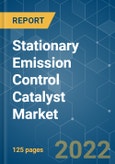The market for stationary emission control catalysts is expected to register a CAGR of over 4% during the forecast period (2022-2027).
The market for stationary emission catalysts is highly concentrated. Some of the major players in the market include Johnson Matthey, Cormetech Inc., Hitachi Zosen Corporation, Umicore, CATALER CORPORATION, and BASF SE, among others.
This product will be delivered within 2 business days.
Key Highlights
- One of the major factors driving the market studied is increasing demand due to stringent emission standards of developed countries and the increasing use of oxidation catalysts on gas turbine power.
- Volatility in Precious Group Metal Prices is likely to act as a restraint to the market studied.
- The development of catalytic components for the developing fuel cell industry is likely to act as an opportunity for the market.
- Europe dominated the global stationary emission control catalyst market, and North America is expected to show the fastest growth during the forecast period.
Key Market Trends
Power Industry to Dominate the Market
- The control of power plant emissions is a major area of application for stationary catalysts. In particular, NOx emissions are removed either by SCR or NOx dissociation. The reduction of NOx from power plants is essential, as it helps to control acid rain and photochemical smog.
- Global coal-fired power generation rebounded strongly in 2021, spurred by rising gas prices in the United States and Europe and increased economic activity in China. With electricity demand outpacing low-carbon supply and steeply rising natural gas prices, global coal power generation is increased by 9% in 2021 to 10,350 terawatt-hours (TWh) - a new all-time high. However, coal’s share of the global power mix in 2022 is expected to be 36%.
- SCR has also been commercialized in Germany, China, and Taiwan. Existing coal-fired plants are generally equipped with emission control systems to reduce traditional pollutants, such as SOx, NOx, and particulate matter.
- In developed countries, the demand is mainly driven by legislative changes. On 14 July 2021, the European Commission adopted a series of legislative proposals setting out how it intends to achieve climate neutrality in the EU by 2050, including the intermediate target of at least 55% net reduction in greenhouse gas emissions by 2030. The package proposes to revise several pieces of EU climate legislation, including the EU ETS, Effort Sharing Regulation, and transport and land use bill, setting out how the Commission intends to reach EU climate targets under the European Green Deal.
- The stationary catalyst segment is growing considerably faster than the underlying industries, owing to constant innovation, which helps client companies save money and allow catalyst producers to charge a premium for their products.
- Hence, the power industry will likely account for the highest market share during the forecast period.
North America to Witness the Highest Growth Rate
- There are over 3,400 fossil-fuel-fired power plants in the United States. Therefore, the emission of harmful gases in the environment was high. To control this, in August 2015, the Environment Protection Agency (EPA) issued the clean power plan.
- In addition to this, the EPA has stationary engine regulations that need to be followed, which are given under National Emission Standards for Hazardous Air Pollutants (NESHAP) and New Source Performance Standards (NSPS). This emission control plan and EPA regulations are driving the market for emission control catalysts in the country.
- The other end-user industry is the chemical industry, which is one of the largest industries in the United States. The United States chemical industry is a USD 768 billion enterprise that accounts for 25% GDP. It is one of the top exporting sectors in the country, accounting for around 15% of the global chemical shipments.
- The United States is a world leader in chemical production and exports. Thus, the consumption of stationary emission control catalysts is high, and it is expected to increase further during the forecast period.
- Canada has emission control guidelines under the Clean Air Act, which are to be followed. Hence, due to these environmental regulations, the consumption of stationary emission control catalysts is increasing.
- Owing to the aforementioned reasons, North America is likely to witness the highest growth rate during the forecast period.
Competitive Landscape
The market for stationary emission catalysts is highly concentrated. Some of the major players in the market include Johnson Matthey, Cormetech Inc., Hitachi Zosen Corporation, Umicore, CATALER CORPORATION, and BASF SE, among others.
Additional Benefits:
- The market estimate (ME) sheet in Excel format
- 3 months of analyst support
This product will be delivered within 2 business days.
Table of Contents
1 INTRODUCTION
4 MARKET DYNAMICS
5 MARKET SEGMENTATION
6 COMPETITIVE LANDSCAPE
Companies Mentioned (Partial List)
A selection of companies mentioned in this report includes, but is not limited to:
- BASF SE
- Cataler Corporation
- CDTi Advanced Materials Inc.
- Clariant
- CRI Catalyst Company
- CORMETECH
- Corning Incorporated
- DCL International Inc.
- Hitachi Zosen Corporation
- Honeywell International Inc.
- IBIDEN Porzellanfabrik Frauenthal
- JGC C&C
- Johnson Matthey
- Umicore








